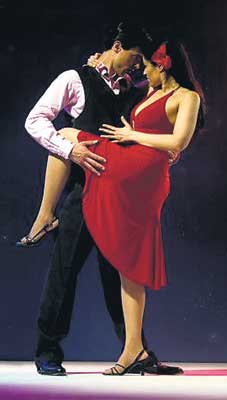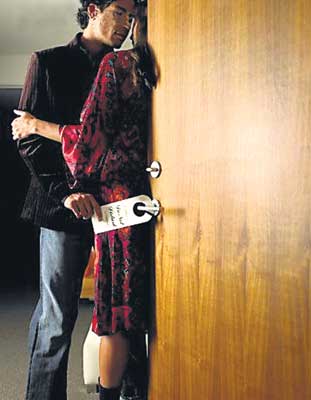
Love on the brain
She walks by, trailing perfume and pheromones. His reaction, which she does not deign to notice, is entirely satisfactory. His jaw hits the floor, his eyes bulge, and then burst out of their sockets as his pupils turn to little red hearts, his pink tongue unrolls and hangs with a thwap, his heart thuds so loud and hard, it seems to almost escape his rib cage, he levitates a few feet off the ground... and then, only then, comes the low, long whistle of ardent appreciation. She doesn't even turn around. If you didn't know this Tomcat so well, you'd be embarrassed for him. Unfortunately Jerry doesn't seem to have much in the way of dignity either. But you just can't hold it against them, because when it comes to the foolish, wild, passionate world of attraction, dignity tends to be in short supply for all of us. So it's no great surprise that scientists are claiming that events that occur in the brain over the course of a person falling in love have distinct similarities to mental illness – you do after all fall 'madly' in love. But what is a bit surprising is their claim that it's also comparable to a drug addiction – cocaine to be precise. However, if you think that rehab is all you need, think again. Half of what attracts you to another person, it turns out, is practically tattooed into your genes. The other half is stuff you don't consciously notice – like scent and the sound they make as they move. The bit about 'the great personality' only comes much, much later. The Checklist At the University of St. Andrews in Scotland, cognitive psychologist David Perrett studies what makes faces attractive. Students are asked to identify the faces they fancy the most. Among the pictures Perrett shows them are images of students' own faces – morphed into a person of the opposite sex. Surprisingly, students having failed to recognize it as their own, always prefer these pictures. Perrett suggests that we find our own faces attractive because they remind us of the faces we looked at constantly in our early childhood years – Mum and Dad. And there's more. New York University researchers have found that the right strut can work wonders. To be found attractive, a woman has to move in a feminine way – swaying her hips. Men, the Proceedings of the National Academy of Sciences paper found, were more attractive if they moved with a "shoulder swagger" and had good, erect posture. Both men and women with slim waists were considered attractive, though men with broad shoulders, and muscular chests were rated as being more attractive.
When it comes to choosing the mother of your children, youth equals fertility. Since it's all downhill for a woman's reproductive system after the grand old age of twenty, men have distinct preferences. One study across 37 cultures showed men desire, on average, a woman 2.5 years younger than themselves for a wife with men in Nigeria and Zambia at the far extreme, desiring their wives to be 6.5 to 7.5 years younger. It becomes apparent that when we look at a potential mate, we are assessing whether we would like our children to have their genes. Some of this stuff is so primal, it's annoying. You've probably heard about men preferring symmetrical faces and hour-glass figures – a waist to hip ratio of 0.7 to be precise. (You can calculate your own using this formula: waist measurement ÷ hip measurement = ratio.) Both these seem to help them gauge a woman's fertility and general health. Such diverse beauty icons as Marilyn Monroe, Sophia Loren, and the Venus de Milo all have ratios around 0.7. In other cultures, preferences vary, ranging from 0.6 in China, to 0.8 or 0.9 in parts of South America and Africa. According to the evolutionary theory, women on the other hand, are creatures of practicality. They tend to be on the lookout for men capable of defending the cave, fathering children and bringing home vast quantities of dead animal. Slim hips is only a bonus. Into this mix comes audition. A person's voice, and the sound of their movements can attract you, but even more potent is reciprocal liking. This psychological term refers to how a person who is liked by another will tend to return that liking. Sniffing out ‘The One’ In 1985, researchers at the University of Colorado found evidence that this organ also exists in most adult humans. (FYI, you ooze pheromones not only in your pee but in your sweat.) At the University of Chicago, Dr Martha McClintock had another Freud moment when her experiment revealed that what women want most is a man who smells similar to her father. Scientists suggest that a woman being attracted to her father's genes makes sense. A man with these genes would be similar enough that her offspring would get a tried and tested immune system. On the other hand, he would be different enough to ensure a wide range of genes for immunity. There seems to be a drive to reach a balance between reckless out-breeding and dangerous inbreeding.
The three phases of love Stage 1 is Lust: Lust is driven by the sex hormones testosterone and oestrogen. Testosterone, it turns out, propels the sex drive of both men and women. Stage 2 is Attraction: love struck and witless, people in the thrall of attraction may be able to think of nothing else. Loss of appetite, insomnia and constant day dreaming are common symptoms. In the attraction stage, a group of neuro-transmitters called 'monoamines' play an important role: Dopamine – Also activated by cocaine and nicotine. Norepinephrine -– Otherwise known as adrenalin. Starts us sweating and gets the heart racing. Serotonin – One of love’s most important chemicals and one that may actually send us temporarily insane. Stage 3 is Attachment: This is serious, lets-walk-down-the-aisle-together love. It's also the let's-procreate-and-take-over-the-world-with-our-numerous-progeny phase. Important in this stage are two hormones released by the nervous system, which are thought to play a role in social attachments: Oxytocin – This is released by the hypothalamus gland during child birth and also helps the breast secrete milk. It helps cement the strong bond between mother and child. It promotes bonding when adults are intimate. Vasopressin – Another important chemical in the long-term commitment stage. Strangely, vasopressin is also known for its role as an important controller of kidney functions. Scent, symmetry, sound; pheromones, hormones, genes; immunity, fertility, and the familiar – love, it seems, is indeed a many splendored thing. |
|| Front
Page | News | Editorial | Columns | Sports | Plus | Financial
Times | International | Mirror | TV
Times | Funday
Times || |
| |
Reproduction of articles permitted when used without any alterations to contents and the source. |
© Copyright
2007 Wijeya
Newspapers Ltd.Colombo. Sri Lanka. All Rights Reserved. |


